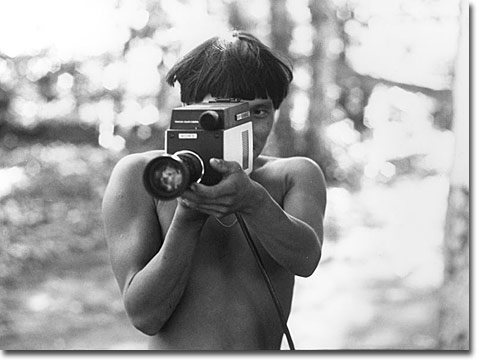Espacio Fundación Telefónica,
Jun 21, 2006 - Aug 20, 2006
Buenos Aires, Argentina
Downey Effect
by María Fernanda Cartagena
Review of the double gazing and postcolonialism contained in the Downey Effect exhibit at the Espacio Fundación Telefónica, with works by Juan Downey, Adriana Bustos, Claudia Casarino, Fredi Casco, Mario Navarro and Ingrid Wildi; Justo Pastor Mellado, curator, and Patricia Hakim, co-curator. * * * Downey Effect, was curatorially conceived by the highly regarded Chilean theorist Justo Pastor Mellado, in conjunction with the artist and active Argentinian cultural promoter Patricia Hakim as co-curator, provides an opportunity for admiring part of the extraordinary universe of Chilean artist Juan Downey (Santiago, Chile, 1949 - New York, USA, 1993). After settling on the East Coast of the United States in 1969, Downey became a pioneer of video art and video installations, and one of the most important artists of the second vanguard of the twentieth century. The exhibit also presents the plausible interconnections between his work and that of the young artists Adriana Bustos (Argentina), Fredi Casco (Paraguay), Mario Navarro (Chile), Ingrid Wildi (born in Chile, resides in Switzerland) and Claudia Casarino (Paraguay). This brief description seems vague given the scope of the curatorial exercise developed by Mellado in his now classic essay El curador como productor de infraestructura [The curator as producer of infrastructure](2001). For the critic, curatorship within a regional context becomes a far-reaching epistemological tool that compensates for the delays in art history and gives support to analytical readings of local history, in contrast with the curaduría de servicio, or the commercial type of curatorship that caters to the entertainment industry. With this in mind, Mellado makes allegorical use of the architectural aspect of the exhibition space. With humor and wit, he places Downey’s work on the first floor, as an economic infrastructure refracting the political-juridical superstructure entrusted to the artists on the second floor. Despite the critical-educational approach of the exhibit, grasping its content is an uphill struggle. The implementation of various devices (works and other documents), a central aspect of Mellado’s thesis, collides with the means of accessing Downey’s videos, which involves a six-hour marathon of uninterrupted viewing (14 videos) on a single channel with audio through headphones. Although tiring, it is an important prerequisite for appreciating the exhibition in its entirety. The effort is well worth it as one discovers Downey’s forcefulness and relevance today. In his classic video installation About Cages (1987), reconstructed for the exhibit, and in the showing of his series Video Trans America (1973-1978) and Ojo pensante [Thinking eye] (1980-1990), what stands out is the artist’s revision of colonialism, imperialism, political repression and official history, thanks to the power of analog video as the forefront technology of its time. His videography calls into question the transparency of the images, the technology sustaining its fictitious objectivity and veracity, the building up of knowledge through representation, and its relationship to power and action. The splendid videos are sensitive essays concerning the thorny matter of the representation of the subalterns, of empire, of art or of mass culture. A precursor of the paths followed by the visual arts, one finds in his work the impact of post-structuralism and of psychoanalysis within contemporary culture. The power relations, that concerned Downey so much filter through to the mechanisms of legitimization, availability and consumption of his own work. The scant dissemination and familiarity with Downey’s work in Latin America - except in his country of origin - came to light in this exhibition. His p
|









